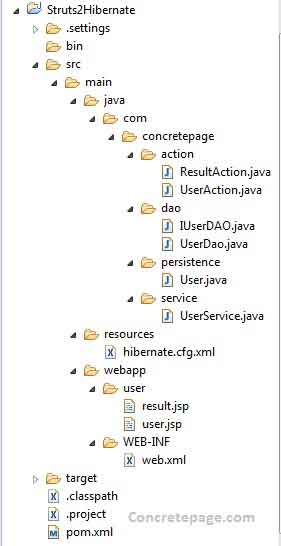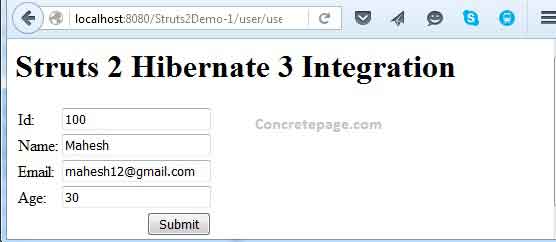Struts 2 + Hibernate Integration with Full-Hibernate-Plugin
March 03, 2016
On this page we will provide struts 2 and hibernate 3 integration with Full-Hibernate-Plugin using @SessionTarget and @TransactionTarget annotation example. Full-Hibernate-Plugin is a third party plugin and not a struts 2 in-built plugin. It makes easy to integrate struts 2 with hibernate. Like spring, we can inject hibernate Session and Transaction in our DAO class using this plugin. Here on this page we will provide a full demo to work with Full-Hibernate-Plugin step by step.
Contents
- Struts 2 Full-Hibernate-Plugin
- @SessionTarget and @TransactionTarget Annotation
- Use of @ParentPackage("hibernate-default") and @InterceptorRef("basicStackHibernate")
- Project Structure in Eclipse
- Database Schema and Entity Class
- Maven to Resolve JAR Dependencies
- hibernate.cfg.xml
- Create DAO and Service Class
- Create Action Class
- web.xml
- Create UI
- Output
- Download Source Code
Struts 2 Full-Hibernate-Plugin
To use Struts 2 Full-Hibernate-Plugin, we need to follow below steps.1. Download struts2-fullhibernatecore-plugin JAR from the URL
https://code.google.com/archive/p/full-hibernate-plugin-for-struts2/downloads and paste at any location, suppose D:\jar\struts2-fullhibernatecore-plugin-2.2.2-GA.jar in Window OS.
2. Now open the command prompt and run the mvn install as follows (I assume that maven is installed in the system).
mvn install:install-file -Dfile=D:\jar\struts2-fullhibernatecore-plugin-2.2.2-GA.jar -DgroupId=com.google.code -DartifactId=struts2-fullhibernatecore-plugin -Dversion=2.2 -Dpackaging=jar -DgeneratePom=true
3. After successful run of the command, now we can get this JAR using maven in our project as usual.
<dependency>
<groupId>com.google.code</groupId>
<artifactId>struts2-fullhibernatecore-plugin</artifactId>
<version>2.2</version>
</dependency>
@SessionTarget and @TransactionTarget Annotation
HibernateSession and Transaction can be injected using Full-Hibernate-Plugin with the below annotations.
@SessionTarget: Instantiate org.hibernate.Session.
@TransactionTarget: Instantiate org.hibernate.Transaction.
Use of @ParentPackage("hibernate-default") and @InterceptorRef("basicStackHibernate")
While integrating struts 2 with hibernate using Full-Hibernate-Plugin, we need to take care three points.1. @ParentPackage("hibernate-default"): Use hibernate-default as parent package which is provided by Full-Hibernate-Plugin.
2. @InterceptorRef("basicStackHibernate"): The package hibernate-default provides three interceptors.
basicStackHibernate
defaultStackHibernate
defaultStackHibernateStrutsValidation.
For hibernate core
Session and Transaction injection capability, we need to use basicStackHibernate interceptor.
3. Use
@SessionTarget and @TransactionTarget annotation at class field in DAO class. If DAO is directly being used in Action class, DAO must be instantiated at class level in Action class. If we introduce a Service class to use DAO then DAO must be instantiated at class level in Service class as well as our Service class must also be instantiated at class level in Action class.
If we do not follow these steps, hibernate
Session and Transaction will be null.
Project Structure in Eclipse
Find the project structure in eclipse.
Database Schema and Entity Class
We are using MySQL database for the demo. Find the table used in example.Table: user
CREATE TABLE `user` ( `id` INT(11) NOT NULL, `age` INT(11) NULL DEFAULT NULL, `email` VARCHAR(255) NULL DEFAULT NULL, `name` VARCHAR(255) NULL DEFAULT NULL, PRIMARY KEY (`id`) ) COLLATE='latin1_swedish_ci' ENGINE=InnoDB;
User.java
package com.concretepage.persistence;
import java.io.Serializable;
import javax.persistence.Column;
import javax.persistence.Entity;
import javax.persistence.Id;
import javax.persistence.Table;
@Table(name="user")
@Entity
public class User implements Serializable {
private static final long serialVersionUID = 1L;
@Id
@Column(name="id")
private int id;
@Column(name="name")
private String name;
@Column(name="email")
private String email;
@Column(name="age")
private int age;
public User(int id, String name, String email,int age){
this.id = id;
this.name = name;
this.email = email;
this.age = age;
}
public int getId() {
return id;
}
public void setId(int id) {
this.id = id;
}
public String getName() {
return name;
}
public void setName(String name) {
this.name = name;
}
public String getEmail() {
return email;
}
public void setEmail(String email) {
this.email = email;
}
public int getAge() {
return age;
}
public void setAge(int age) {
this.age = age;
}
}
Maven to Resolve JAR Dependencies
Find the maven file to resolve JAR dependencies.pom.xml
<project xmlns="http://maven.apache.org/POM/4.0.0" xmlns:xsi="http://www.w3.org/2001/XMLSchema-instance"
xsi:schemaLocation="http://maven.apache.org/POM/4.0.0 http://maven.apache.org/maven-v4_0_0.xsd">
<modelVersion>4.0.0</modelVersion>
<groupId>com.concretepage</groupId>
<artifactId>Struts2Demo</artifactId>
<packaging>war</packaging>
<version>1</version>
<name>Struts2Hibernate</name>
<dependencies>
<dependency>
<groupId>org.apache.struts</groupId>
<artifactId>struts2-core</artifactId>
<version>2.3.16</version>
</dependency>
<dependency>
<groupId>org.apache.struts</groupId>
<artifactId>struts2-convention-plugin</artifactId>
<version>2.3.8</version>
</dependency>
<dependency>
<groupId>org.hibernate</groupId>
<artifactId>hibernate-annotations</artifactId>
<version>3.5.6-Final</version>
</dependency>
<dependency>
<groupId>org.hibernate.javax.persistence</groupId>
<artifactId>hibernate-jpa-2.0-api</artifactId>
<version>1.0.1.Final</version>
</dependency>
<dependency>
<groupId>org.hibernate</groupId>
<artifactId>hibernate-validator</artifactId>
<version>4.1.0.Final</version>
</dependency>
<dependency>
<groupId>org.slf4j</groupId>
<artifactId>slf4j-api</artifactId>
<version>1.7.7</version>
</dependency>
<dependency>
<groupId>log4j</groupId>
<artifactId>log4j</artifactId>
<version>1.2.16</version>
</dependency>
<dependency>
<groupId>mysql</groupId>
<artifactId>mysql-connector-java</artifactId>
<version>5.1.17</version>
</dependency>
<dependency>
<groupId>com.google.code</groupId>
<artifactId>struts2-fullhibernatecore-plugin</artifactId>
<version>2.2</version>
</dependency>
</dependencies>
</project>
hibernate.cfg.xml
<hibernate-configuration>
<session-factory>
<property name="connection.driver_class">com.mysql.jdbc.Driver</property>
<property name="hibernate.connection.url">
jdbc:mysql://localhost:3306/concretepage</property>
<property name="hibernate.connection.username">root</property>
<property name="hibernate.connection.password"></property>
<property name="hibernate.connection.pool_size">10</property>
<property name="show_sql">true</property>
<property name="dialect">org.hibernate.dialect.MySQLDialect</property>
<property name="hibernate.hbm2ddl.auto">update</property>
<mapping class="com.concretepage.persistence.User"/>
</session-factory>
</hibernate-configuration>
Create DAO and Service Class
IUserDAO.java
package com.concretepage.dao;
import com.concretepage.persistence.User;
public interface IUserDAO {
void saveUserDetail(User user);
}
package com.concretepage.dao;
import org.hibernate.Session;
import org.hibernate.Transaction;
import com.concretepage.persistence.User;
import com.googlecode.s2hibernate.struts2.plugin.annotations.SessionTarget;
import com.googlecode.s2hibernate.struts2.plugin.annotations.TransactionTarget;
public class UserDao implements IUserDAO {
@SessionTarget
private Session session;
@TransactionTarget
private Transaction transaction;
@Override
public void saveUserDetail(User user){
session.save(user);
System.out.println("done");
}
}
package com.concretepage.service;
import com.concretepage.dao.IUserDAO;
import com.concretepage.dao.UserDao;
import com.concretepage.persistence.User;
public class UserService {
private IUserDAO userDao = new UserDao();
public void saveUserDetail(User user){
userDao.saveUserDetail(user);
}
}
Create Action Class
UserAction.java
package com.concretepage.action;
import org.apache.struts2.convention.annotation.Action;
import org.apache.struts2.convention.annotation.Namespace;
import org.apache.struts2.convention.annotation.Result;
import org.apache.struts2.convention.annotation.ResultPath;
import com.opensymphony.xwork2.ActionSupport;
@Namespace("/user")
@Action("/user")
@ResultPath(value="/")
@Result(name="success",location="user.jsp")
public class UserAction extends ActionSupport{
public String execute() {
return SUCCESS;
}
}
package com.concretepage.action;
import org.apache.struts2.convention.annotation.Action;
import org.apache.struts2.convention.annotation.InterceptorRef;
import org.apache.struts2.convention.annotation.Namespace;
import org.apache.struts2.convention.annotation.ParentPackage;
import org.apache.struts2.convention.annotation.Result;
import org.apache.struts2.convention.annotation.ResultPath;
import com.concretepage.persistence.User;
import com.concretepage.service.UserService;
import com.opensymphony.xwork2.ActionSupport;
@ParentPackage("hibernate-default")
@Namespace("/user")
@ResultPath(value="/")
@InterceptorRef("basicStackHibernate")
public class ResultAction extends ActionSupport{
private static final long serialVersionUID = 1L;
private int id;
private String name;
private String email;
private int age;
private UserService service = new UserService();
@Action(value="save", results={@Result(name="success",location="result.jsp")})
public String save() {
User user = new User(id, name, email, age);
service.saveUserDetail(user);
return SUCCESS;
}
public String getName() {
return name;
}
public void setName(String name) {
this.name = name;
}
public String getEmail() {
return email;
}
public void setEmail(String email) {
this.email = email;
}
public int getAge() {
return age;
}
public void setAge(int age) {
this.age = age;
}
public int getId() {
return id;
}
public void setId(int id) {
this.id = id;
}
}
web.xml
<web-app>
<display-name>Struts 2 Validation Annotation Example</display-name>
<filter>
<filter-name>struts2</filter-name>
<filter-class>org.apache.struts2.dispatcher.ng.filter.StrutsPrepareAndExecuteFilter</filter-class>
</filter>
<filter-mapping>
<filter-name>struts2</filter-name>
<url-pattern>/*</url-pattern>
</filter-mapping>
</web-app>
Create UI
user.jsp<%@ taglib prefix="s" uri="/struts-tags" %> <html> <head><title>Struts 2 Hibernate 3 Integration</title> </head> <body> <h1>Struts 2 Hibernate 3 Integration</h1> <s:form action="save" validate="true" > <s:textfield name="id" label="Id"/> <s:textfield name="name" label="Name"/> <s:textfield name="email" label="Email"/> <s:textfield name="age" label ="Age"/> <s:submit method="execute"/> </s:form> </body> </html>
<html> <head><head><title>Struts 2 Hibernate 3 Integration</title> </head> <body> <h1>User Detail is saved successfully.</h1> </body> </html>
Output
UI One:


done Hibernate: insert into user (age, email, name, id) values (?, ?, ?, ?)


